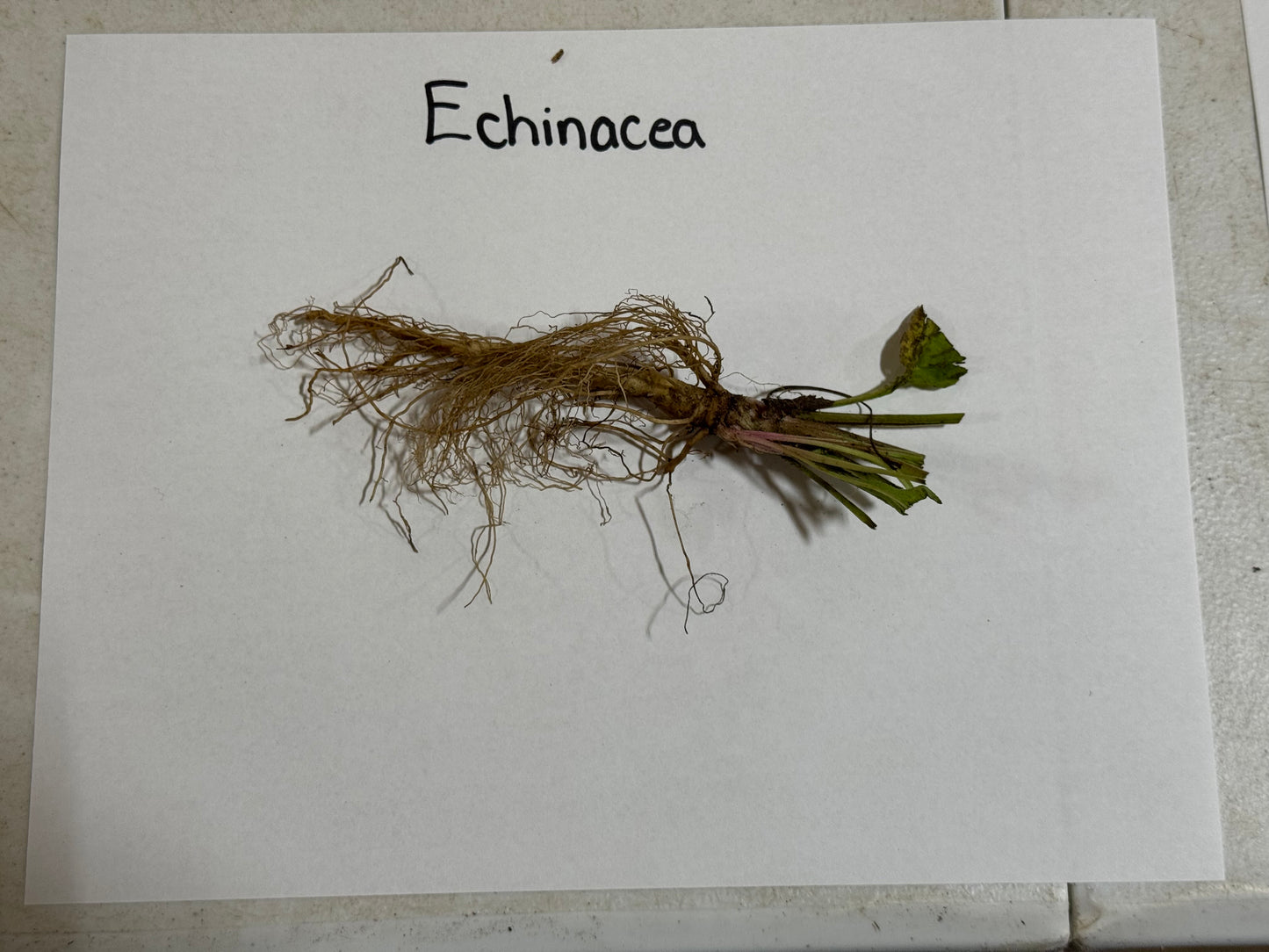Couldn't load pickup availability
🌸When you add 1 plant to cart, it automatically adds the free one
Echinacea Plant Attracts Numerous Pollinators to Landscapes
The Echinacea Plant is a pollinator plant and a magnet for hummingbirds, bees, and butterflies. Known as Echinacea purpurea in Latin, it is native to central and southeastern North America and commonly grows along woodland edges, prairies, and roadsides. It is a well-known medicinal plant known as ‘Purple Coneflower’ and has been used extensively to treat many ailments.
This quaint, yet vibrant flower blooms from early to late summer, and like a sunflower, follows the sun as it shifts across the sky. Coppery in color, the center of the inflorescence is made of hundreds of tiny, individual flowers called disk florets. These florets appear spikey due to the rigidness of the bracts that extend far beyond each floret’s length.
Echinacea purpurea Plant Details
Family: Asteraceae
Hardiness Zones: 3 to 9
Light Requirement: Full sun to partial shade
Water Needs: Moderate
Height: 2 to 4 ft
Spread: 1.5 to 2 ft
Growth Rate: Moderate
Bloom Time: Early summer through mid-autumn
Flower Color: Pinkish-purple petals with a prominent orange-brown central cone
Wildlife Value: Attractive to pollinators, and seeds are a food source for finches
Pollinators adore this perennial, which will ensure a flurry of activity in the garden. Golden finches are particular fans of this flower, feasting upon its seeds.
Uses For The Echinacea Plant
The Echinacea Plant makes excellent cut flowers. The flowers persist on long, sturdy stems and remain fresh for extended periods. The petals are edible and slightly sweet. Plant these delightful perennials next to your kitchen door and in your patio garden to regularly enjoy the sight and taste of these charming flowers.
How to Grow and Maintain Echinacea Plants
This perennial requires well-drained soil and does not tolerate wet feet. It does best when planted in moderate to dry soils. Due to its long taproot, it is a drought-tolerant species. It thrives in full to partial sun conditions and requires at least four hours of sun per day to be productive.
Easy to grow, this perennial is deer-resistant and free of serious pest or disease issues. The finished flowers can be deadheaded to encourage future blooms. If growing this plant from seed, remember that seeds require stratification (a cold, moist period) to germinate.
Why Choose Echinacea Plants for Pollinator Gardens
Attracts pollinators, ideal as cut flowers, and drought tolerant. The subtle beauty of this productive perennial will have you and the Golden Finches looking forward to its tasty petals and seeds year on year. Shop for the Echinacea Plant online at TN Nursery. For 68 years, we have served the landscaping industry and homeowners with specimen plants.
This Is How Your Plants Will Look upon Delivery

Bloom Season
Summer
Bloom/Foliage Color
Purple
Height at Maturity
Over 12"
Care
Echinacea plants thrive in well-draining soil with regular watering. They are generally drought-tolerant once established. Remove spent flowers to encourage continuous blooming. Prune back dead stems in late fall or early spring. Fertilize lightly in early spring for best growth.
Plant Reproduction
Echinacea Plant spreads naturally through self-seeding
How to Grow and Care for Bare Root Perennials, Tubers, and Bulbs
Bare root perennials, tubers, and bulbs are an easy and economical way to jumpstart your garden with lasting beauty. These dormant plants should be planted in early spring or fall while the soil is cool and workable. Before planting, soak bare roots in water for 1–2 hours to rehydrate them. Choose a location based on the plant’s light needs—most flowering types prefer full sun, while others thrive in partial shade.
For bare root perennials, dig a shallow hole and spread the roots out naturally, ensuring the crown is level with the soil surface. For tubers and bulbs, plant with the pointed side facing up at a depth about two to three times their height. Cover with soil, gently press down, and water thoroughly.
Keep soil consistently moist (not soggy) until new growth appears. Add mulch to retain moisture and suppress weeds, but avoid covering the crown or bulb tops. Once established, these plants require little maintenance—just seasonal watering, occasional dividing, and deadheading or pruning as needed. With proper care, they’ll return and thrive year after year.
Shipping date depends on the date displayed and chosen when you order from the product's page.
We only accept returns on plants verified dead. If you think your plants have died, we offer a 1 year warranty, please use use this File a Claim Link to verify dead plants and start with return warranty process.




Caring Tips
How do I care for my Echinacea Plant?
Each box contains detailed care instructions and information about your product. But here's the basics.
Care Tips
Echinacea plants thrive in well-draining soil with regular watering. They are generally drought-tolerant once established. Remove spent flowers to encourage continuous blooming. Prune back dead stems in late fall or early spring. Fertilize lightly in early spring for best growth.
Light Requirements
Echinacea, commonly known as coneflower, flourishes in full sun, needing 6 hours of direct daylight daily. It can tolerate partial shade but will bloom less abundantly. Full sun ensures the healthiest growth and vibrant flowering.
Hardy Planting Zones
3 • 4 • 5 • 6 • 7 • 8 • 9
The plant came healthy, started blooming within weeks, and now it’s the star of my flower bed. Perfect purchase!
I love the Echinacea, though one of the leaves looked a bit wilted when it came. After watering, it bounced back nicely.
I was happy with how well the plant was packaged. It looks good in my garden bed and I’m excited to see how it does next year.
The Echinacea plant came in healthy condition and adjusted quickly. It’s already starting to bloom, and the colors are beautiful.
Delivery was quick, but the plant looked a little weak when it arrived. It’s hanging in there, just taking longer to perk up.





